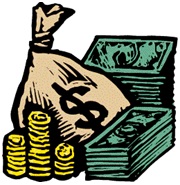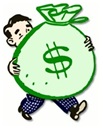|
 |
|
 |
Financial accounting
Financial accounting is... Concerned with:
The other type of accounting is management accounting which uses information from an organization’s accounts to improve its performance. This is examined in five other sections: • Costing and break-even analysis. • Capital investment appraisal.
Accounts are...
British companies have to publish these accounts every year in their annual reports:
1. Income statement (or profit and loss account) The company’s revenue and expenses (see below).
2. Balance sheet The things it owns (assets) and money it owes (liabilities) – see below.
3. Cash flow statement Cash coming in and out of the company (see cash flow management).
Companies are...
There are two types of companies in Britain:
1. Public limited companies (plcs) These:
2. Private limited companies These are usually smaller companies that can’t publicly sell their shares. In Britain over 99% of companies are private but plcs are much bigger and more powerful.
Why are they called limited companies?
Because liability for debts of their owners (shareholders, or owners of shares) is limited to the value of their shares. This is called limited liability.
What are the two types of shareholders?
1. Ordinary shareholders
Most ordinary shares in public companies are owned by financial institutions like pension funds and insurance companies.
2. Preference shareholders -who usually:
The value of shares in the balance sheet is based on their nominal (or par) value, not their market value.
Accounts in more detail...
Balance sheet
This is a snapshot (on a particular day) of an organization’s
Here they are in more detail.
Owners’ capital
This comes from: 1. Shareholders’ equity Money from:
2. Minority interests Shares in its subsidiary companies that the company doesn’t own.
Assets
These are things the company owns: 1. Current assets Cash or convertible into cash within one year from the date of the balance sheet (see below).
2. Fixed assets Assets kept for over a year like machinery (see below).
Liabilities
This is money the company owes to suppliers and lenders of capital, or money: 1. Current liabilities are due to be paid within one year from the date of the balance sheet.
2. Liabilities due after a year like loans.
This equation will always be true: Assets = owners’ capital + liabilities or...
You can see this in the British supermarket Tesco’s 2014 balance sheet:
Tesco – Balance sheet on 22 February 2014 £million (figures in brackets are deducted)
Non-current assets 34,592 Current assets 15,572 Current liabilities (21,399) Net current liabilities (5, 827) Total assets less current liabilities 28,765 Non-current liabilities (14, 043) Net assets 14,722
Equity (or shareholders’ equity) 14,715 Minority interests 7 Total equity 14,722
What do these terms mean?
Non-current assets (or fixed assets) Assets held in the organization for a long time. Spending on them is called capital expenditure, and they can be:
1. Tangible Property, plant and equipment (e.g. retail stores, factories and machinery). Depreciation (an expense in the income statement – see below) is often deducted from these assets to set aside money to eventually replace them.
2. Intangible (like customer goodwill, patents and copyrights).
Current assets Cash or convertible into cash within one year of the date of the balance sheet (in our example 27 February 2014). The main ones are:
1. Cash
2. Short-term financial investments
3. Trade and other receivables Customers and other business associates who haven’t paid yet Unpaid customers are called:
Tesco doesn’t have any because all its customers pay immediately.
4. Inventories (usually called stocks in Britain) Unsold goods and for manufacturers
Current liabilities
Debts that have to be paid within one year of the date of the balance sheet.
The main ones are:
1. Trade and other payables (unpaid suppliers) Often called:
2. Short-term borrowings (including bank overdrafts). Note that current liabilities (and non-current liabilities – see below) are deducted from assets in the balance sheet.
Net current liabilities/assets Current assets and current assets added together:
1. Net current liabilities These occur when current liabilities are greater than current assets (usual for a supermarket like Tesco, because customers pay in cash, making debtors, a current asset, extremely low) .
2. Net current assets These occur when current assets are greater than current liabilities. This is often called working capital – see cash flow management).
Non-current liabilities
Debts that have to be paid at least one year from the date of the balance sheet.
These are mainly medium/long-term borrowings including:
1. Bank loans
2. Debentures Loans to companies from their buyers (called debenture holders).
Net assets
Total assets less total liabilities
This would be net liabilities, if liabilities were greater than assets.
Equity
Owners’ capital (or money) from
Minority interests Shares that the company doesn’t own in its subsidiary companies.
What happens to a company’s profits...
They go to: 1. Shareholders (in dividends).
2. Reserves (reinvested profits) Put back into the business for expansion and buying new assets.
3. The government (in tax paid on profits – corporation tax in British companies like Tesco).
Income statement (or profit and loss account) This shows an organization’s trading income and current expenditure (all spending except for capital expenditure on fixed assets) over a year (called the accounting year). To illustrate this, we’ll have another look at Tesco. Tesco – Income statement year ended 22 February 2014 £million (figures in brackets are deducted) Revenue (turnover) 63,557 Gross profit 4,010 Operating profit 2,631 Profit before tax 2,259 Loss for year from discontinued operations (942) Profit for the year (or profit after tax) 970
What do these terms mean?
Revenue (or turnover) This is the year’s sales revenue – the number of products sold multiplied by their price (excluding sales taxes like VAT).
Cost of sales
This is the year’s direct expenses relating directly to the company’s provision of goods and/or services.
For Tesco this is the goods it bought and sold during the year
For a manufacturer this will include purchases of raw materials.
Gross profit Revenue (turnover) less the cost of sales.
Administrative expenses This will include transport, selling and administrative costs.
Profit arising on property-related items Profit from property sales.
Operating profit The profit earned on the organization’s trading activities excluding interest earned on investments (finance income) or paid on loans (finance costs).
Profits from joint ventures and associates Profits from partnerships with other companies.
Profit before tax Profit before the payment of tax (corporation tax for Tesco).
Loss for year from discontinued operations Losses from closed businesses
Profit for the year (or profit after tax) Profit after the payment of tax.
Key quotes explained
“Accounting...never hesitates to sacrifice human life to figures that look well on paper” - Simone Weil (French philosopher, pictured right) People’s lives are more important than the primary concerns of accounting – profit and cost minimization.
“Not everything that counts can be counted, and not everything that can be counted counts”, Albert Einstein (pictured right), said a sign in his office. Non-financial measures (like motivation and learning) can’t be overlooked.
“A true and fair view” A company (and any other organization) must have its accounts checked by an independent auditor who must honestly say that they give “a true and fair view” of its financial position. The auditors failed to do this In the fraud scandals at the American companies, Enron and WorldCom in the early 2000’s.
“Keep your accounts on your thumb-nail” -Henry David Thoreau (American philosopher, pictured right). Simple living is best with low expenditures and less need to earn so much. |
|
|
||
|
|
|
||
|
||
| Copyright © wisdomtowin.com All Rights Reserved | ||
|







